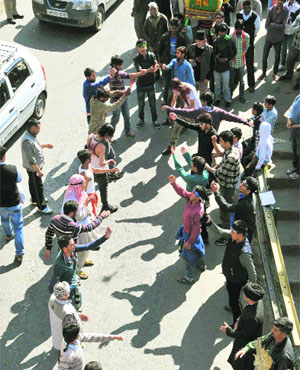
Muharram Procession in Shimla
Dr.Mazhar Naqvi
The ‘Laddakhi’ Imambara in
Shimla deserves more awareness among the Imamis. It is probably the only
Imambara that owes its existence not to any ruler or affluent person but to the
collective efforts of poor porters. Obviously, the Imambara in terms of
architecture is not a visual treat like majestic Imambara of Lucknow but the
spirit behind its construction is undoubtedly matchless. The blogger says so
because Laddakhi Imambara symbolizes that nothing can dampen the spirit of an Imami
and he would perform Aza-E-Hussain wherever the destiny takes him and it makes
no difference to him whether he has the resources to mourn the martyrdom of Imam
or not. Shimla is the capital of the northern Indian
state of Himachal Pradesh, in the Himalayan foothills.
Once the summer capital of British India;
Shimla has a very interesting history of its origin, gradual growth and
development. It was taken from the Jhind Rana in 1815 and given to the Patiala King
for assisting the British in the Nepal War. It is however, claimed by Mr. A.
Wilson in his ‘Abode of Snow’ that Shimla was first made known by Gerard brothers. Their
diary, dated August 30th, 1817, describes Shimla as a village where a fakir
gives water to travelers. In 1819, Lt. Ross, Assistant Political Agent - Hill
States, built a cottage of wood and thatch. This was probably the first British
House in Shimla. In 1827, Lord Amherst, the then Governor General of India, visited
Shimla to spend summer months there. Thereafter, the movement of British
Officers to Shimla in the summers became a regular phenomenon. Another factor
that enhanced the popularity of Shimla was its health giving attribute.
The large-scale program of
construction, especially roads and bridges to facilitate travelling to Shimla attracted
a large number of laborers from Laddakh. They sold their labor to make their own ends meet. The tradition of migrant labor
in Laddakh has been documented since at least the mid-19th century. A traveler
in 1852 found most of Leh’s male population absent, working in the sulphur and
borax mines at Puga, leaving the womenfolk to work as porters, both carrying travelers’
baggage on the roads and shifting loads of merchandise in Leh bazaar. As Shimla
offered comparatively high prices for coolie labor, Laddakhis left their native
place to work as porters in the merging British summer capital. They were
engaged primarily for bringing planks, heavy beams and rough timber for
building purposes from the forests. They settled in an area below the cart road
that is today known as Laddakhi Mohalla. By 1910, it was an established fact
that most of the load- carrying porters called as Coolies in local parlance, as
opposed to the rickshaw-pullers—in Shimla were either Kashmiris, or Imamis from
Kargil. It is these porters who constructed the Imambara and even British have
narrated in their accounts that the social life of Laddakhis centered in and around
the shrine erected in memory of Karbala martyrs. The Imambara is at present
under the management of Anjuman-E-Haideri that is also the chief organizer of
Aza-E-Hussain in Shimla during Muharram every year. The role of Anjuman is
praise worthy in view of very less number of Imamis in Shimla.
No comments:
Post a Comment